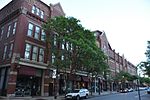New Hampshire Institute of Art
1898 establishments in New HampshireArt schools in New HampshireArts organizations established in 1898Educational buildings in Manchester, New HampshireEducational institutions established in 1898 ... and 3 more
New England CollegePrivate universities and colleges in New HampshireUniversities and colleges in Hillsborough County, New Hampshire

The New Hampshire Institute of Art (NHIA) was a private art school in Manchester, New Hampshire. It was accredited by the National Association of Schools of Art and Design (NASAD) and the New England Association of Schools and Colleges (NEASC) and was a member of the Association of Independent Colleges of Art and Design (AICAD). NHIA offered the Bachelor of Fine Arts as well as Master of Fine Arts and Master of Arts in Teaching. In 2019, the institute merged with New England College and is now the college's Manchester campus.
Excerpt from the Wikipedia article New Hampshire Institute of Art (License: CC BY-SA 3.0, Authors, Images).New Hampshire Institute of Art
Amherst Street, Manchester
Geographical coordinates (GPS) Address Phone number Website Nearby Places Show on map
Geographical coordinates (GPS)
| Latitude | Longitude |
|---|---|
| N 42.991666666667 ° | E -71.460833333333 ° |
Address
Olga's Tailor Shop
Amherst Street 83
03101 Manchester
New Hampshire, United States
Open on Google Maps






